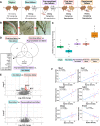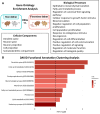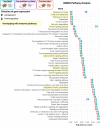Male caregiving experience alters hippocampal neuroplasticity and transcription independent of reproduction in a biparental species
- PMID: 40804339
- PMCID: PMC12350739
- DOI: 10.1038/s42003-025-08530-w
Male caregiving experience alters hippocampal neuroplasticity and transcription independent of reproduction in a biparental species
Abstract
In mammals, measurable changes in brain and behavior accompany the transition to parenthood. In the biparental California mouse, Peromyscus californicus, fathers experience enhanced neuroplasticity, including increased hippocampal dendritic spine density, reduced anxiety, and improved memory. Here, we first investigate whether siring offspring or pup interaction drives structural neuroplasticity in fathers and find that hippocampal spine density is positively associated with caregiving experience, even in the absence of reproduction. Next, we evaluate the transcriptional response to caregiving in the hippocampus of these males and identify 158 differentially expressed genes between fathers and non-fathers, many of which are associated with neurogenesis, neuronal signaling, and dendritic plasticity. Importantly, 11 of the differentially expressed genes in fathers are similarly regulated in non-fathers that interacted with unrelated pups, suggesting that even limited interaction with pups, in the absence of siring a litter, can induce transcriptional changes in the male brain. Moreover, of the differentially expressed genes that encode for transcription factors and cofactors, we repeatedly find that their expression correlates with spine density in males with varied caregiving experience, thus linking these transcriptional changes to neuroplasticity. Together, this work demonstrates that caregiving-regardless of whether the pups are the male's own biological offspring-drives hippocampal neuroplasticity and transcriptional changes in males of a biparental species.
© 2025. The Author(s).
Conflict of interest statement
Competing interests: The authors declare no competing interests.
Figures




Similar articles
-
Short-Term Memory Impairment.2024 Jun 8. In: StatPearls [Internet]. Treasure Island (FL): StatPearls Publishing; 2025 Jan–. 2024 Jun 8. In: StatPearls [Internet]. Treasure Island (FL): StatPearls Publishing; 2025 Jan–. PMID: 31424720 Free Books & Documents.
-
Drosophila seminal sex peptide associates with rival as well as own sperm, providing SP function in polyandrous females.Elife. 2020 Jul 16;9:e58322. doi: 10.7554/eLife.58322. Elife. 2020. PMID: 32672537 Free PMC article.
-
Effects of parental care on skin microbial community composition in poison frogs.Elife. 2025 Jul 31;14:RP103331. doi: 10.7554/eLife.103331. Elife. 2025. PMID: 40742751 Free PMC article.
-
How lived experiences of illness trajectories, burdens of treatment, and social inequalities shape service user and caregiver participation in health and social care: a theory-informed qualitative evidence synthesis.Health Soc Care Deliv Res. 2025 Jun;13(24):1-120. doi: 10.3310/HGTQ8159. Health Soc Care Deliv Res. 2025. PMID: 40548558
-
Gender differences in the context of interventions for improving health literacy in migrants: a qualitative evidence synthesis.Cochrane Database Syst Rev. 2024 Dec 12;12(12):CD013302. doi: 10.1002/14651858.CD013302.pub2. Cochrane Database Syst Rev. 2024. PMID: 39665382
References
-
- Dewsbury, D. A. Paternal behavior in rodents. Integr. Comp. Biol.25, 841–852 (1985).
-
- Glasper, E. R., Kenkel, W. M., Bick, J. & Rilling, J. K. More than just mothers: the neurobiological and neuroendocrine underpinnings of allomaternal caregiving. Front. Neuroendocrinol.53, 100741 (2019). - PubMed
LinkOut - more resources
Full Text Sources

